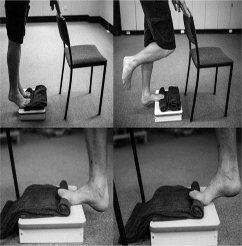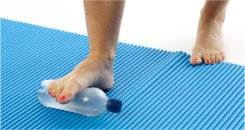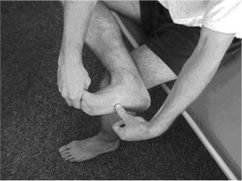 My name is Natalie March from Physio-logical, a Chartered Physiotherapist based within My Fitness Hub, Havant and in Rowlands Castle in the PO postcode areas. Myself and our two other physiotherapists and soft tissue therapists offer hands on physiotherapy, rehabilitation exercises, acupuncture and sports massage treatments both within our two clinics and we also offer home visits too. I hope you found our last self-help exercises for sciatica useful.
My name is Natalie March from Physio-logical, a Chartered Physiotherapist based within My Fitness Hub, Havant and in Rowlands Castle in the PO postcode areas. Myself and our two other physiotherapists and soft tissue therapists offer hands on physiotherapy, rehabilitation exercises, acupuncture and sports massage treatments both within our two clinics and we also offer home visits too. I hope you found our last self-help exercises for sciatica useful.
So today’s subject is “Plantarfaciitis, I have had it ages, what can I do to help?”
Here is a testimonial from one of our clients who had plantarfaciitis:
“I completed my first Ironman 70.3 with the help of Natalie. Putting up with symptoms of plantarfaciitis for months before letting it get so bad that I couldn't walk without limping or run without experiencing constant pain. In July I finally went to see Natalie something I should have done back in December. I actually didn't expect to run the 13.1 miles yesterday pain free but I did and also pain free after. I really can't thank Natalie enough.” Mrs. A.
We have seen a lot of patients suffering from plantarfaciitis in our physiotherapy clinics recently.
What is plantarfaciitis?
Plantarfasciitis is the third most common injury in runners and approximately 10% of people have plantarfasciitis at some point during their lifetime. It is a pain in the heel and underside of the foot.
The plantarfacia itself is a tough band of fibrous tissue that extends from the heel bone to the toes. It supports the arch of your foot and takes a lot of load during walking and running. Plantarfaciitis is an overuse injury to the facial sheet on the sole of the foot.
Cause of Plantarfaciitis
- When there is an increased load placed on the plantarfacia by running, walking, playing tennis or by a patient’s biomechanics.
- Tight calf muscles
- Poor footwear
- Poor glutes control
- Calf muscle weakness
What are the symptoms of Plantarfaciitis?
People with plantarfaciitis may have a number of symptoms including:
- Pain on the bottom of your foot, sometimes going into your heel.
- Usually the first few steps in the morning are painful but this gradually settles as you continue walking.
- Walking barefoot, on your toes, going up stairs and running all tend to aggravate the pain.
Treatment
There are lots of different treatment options from taping, to sports massage to release of tight calf muscles and plantarfascia, ankle joint mobilisation, strengthening exercises, stretches, acupuncture and ultrasound.
Please be aware of your body and take advice from your GP before exercising or send an email to (enquiries@physio-logical.net) for advice and guidance.
Plantar Fascia Stretch
- Hold the stretch for 10 seconds, repeat 10 times, at least 3 x day
- Do this exercise before taking your first step in the morning, and before standing after prolonged sitting
Frozen Can Roll
- Roll your bare injured foot back and forth from your heel to your mind-arch over a frozen can or bottle.
- Repeat for 3-5 minutes. This exercise is particular helpful if done first thing in the morning or at the end of the day.
If any of the above sounds familiar or if you suffer from plantarfaciitis then we can help you here at Physio-logical in Havant and Rowlands Castle. We all regularly see patients with a wide range of foot and heel pain symptoms. Call our clinic today on 07835 712306 to find out more about how our team of experienced Physiotherapists and soft tissue therapist can help. Alternatively you can get in contact with us via enquiries@physio-logical.net or book online at https://physio-logical.net/contact-us/
Heel Raise

- Every second day for three months.
- Every heel-rise consisted of a three second concentric phase (going up) and a three second eccentric phase (coming down) with a 2 second isometric phase (pause at the top of the exercise).
- The high-load strength training was slowly progressed throughout the trial as previously reported by Kongsgaard et al.
- 12 repetition maximum (RM) for three sets.
- After two weeks, they increased the load by using a backpack with books and reduced the number of repetitions to 10RM, simultaneously increasing the number of sets to four.
- After four weeks, they were instructed to perform 8RM and perform five sets.
- They were instructed to keep adding books to the backpack as they became stronger.
- A key clinical point is that the calf-raises need to be done slowly.

New stretch proven to dramatically relieve pain from Plantarfasciitis

A new stretch is proving quite effective to help treat and potentially cure plantar fasciitis, a condition that affects nearly 2.5 million Americans each year. In a study recently published in Journal of Bone and Joint Surgery, researchers found that patients suffering from the painful heel spur syndrome had a 75 percent chance of having no pain and returning to full activity within three to six months of performing the stretch. In addition, patients have about a 75 percent chance of needing no further treatment.
The study is a two-year follow-up on 82 patients with plantar fasciitis, all of whom were part of an original clinical trial of 101 patients in 2003. The patients were taught a new stretch that specifically targets the plantar fascia developed by Benedict DiGiovanni. M.D., associate professor of orthopaedic surgery at the University of Rochester and author of the study, and Deborah Nawoczenski, P.T., Ph.D., professor of physical therapy at Ithaca College.
The stretch requires patients to sit with one leg crossed over the other, and stretch the arch of the foot by taking one hand and pulling the toes back toward the shin for a count of 10. The exercise must be repeated 10 times, and performed at least three times a day, including before taking the first step in the morning and before standing after a prolonged period of sitting. More than 90 percent of the patients were totally satisfied or satisfied with minor reservations, and noted distinct in pain and activity limitations.